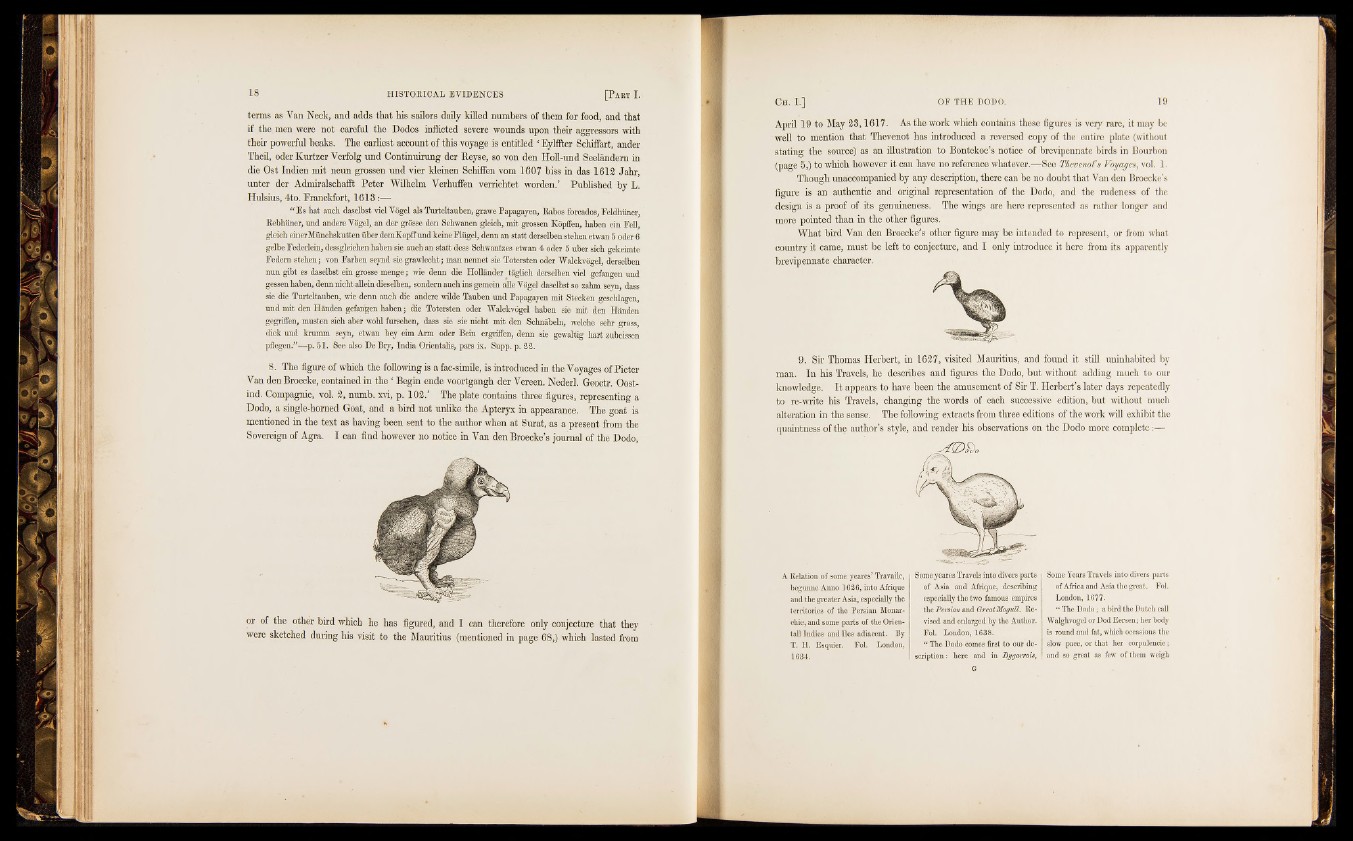
terms as Van Neck, and adds that his sailors daily killed numbers of them for food, and that
if the men were not careful the Dodos inflicted severe wounds upon their aggressors with
their powerful beaks. The earliest account of this voyage is entitled ‘Eylffter Schiffart, ander
Theil, oder Kurtzer Verfolg und Continuirung der Reyse, so von den Holl-und Seeländern in
die Ost Indien mit neun grossen und vier kleinen Schiffen vom 1607 biss in das 1612 Jahr,
unter der Admiralschafft Peter Wilhelm Verhuffen verrichtet worden.’ Published by L.
Hulsius, 4to. Pranckfort, 1618:—
"Es hat auch daselbst viel Vögel als Turteltauben, grawe Papagayen, Rabos forcados, Eeldhüner,
Rebhüner, und andere Vögel,, an der grösse den Schwanen gleich, mit grossen Köpffen, haben ein Pell,
gleich einer Münchskutten über demKopff und keine Elügel, denn an statt derselben stehen etwan 5 oder 6
gelbe Pederlein, dessgleichen haben sie auch an statt dess Schwantzes etwan 4 oder 5 über sich gekeimte
Pedem stehen; von Parben seynd sie grawlecht; man nennet sie Totersten oder Walckvögel, derselben
nun gibt es daselbst ein grosse menge; wie denn die Holländer täglich derselben viel gefangen und
gessen haben, denn nicht allein dieselben, sondern auch ins gemein alle Vögel daselbst so zahm seyn, dass
sie die Turteltauben, wie denn auch die andere wilde Tauben und Papagayen mit Stecken geschlagen,
und mit den Händen gefangen haben; die Totersten oder Walckvögel haben sie mit den Händen
gegriffen, musten sich aber wohl fursehen, dass sie sie nicht mit den Schnäbeln, welche sehr gross,
dick und krumm seyn, etwan bey eim Arm oder Bein ergriffen, denn sie gewaltig hart zubeissen
pflegen.”—p. 51. See also De Bry, India Orientalis, pars ix. Supp. p. 22.
8. The figure of which the following is a fac-simile, is introduced in the Voyages of Pieter
Van den Broecke, contained in the ‘ Begin ende voortgangh der Vereen. Nederl. Geoctr. Oost-
ind. Compagnie, vol. 2, numb, xvi, p . 102/ The plate contains three figures, representing a
Dodo, a single-horned Goat, and a bird not unlike the Apteryx in appearance. The goat is
mentioned in the text as having been sent to the author when at Surat, as a present from the
Sovereign of Agra. I can find however no notice in Van den Broecke’s journal of the Dodo,
or of the other bird which he has figured, and I can therefore only conjecture that they
were sketched during his visit to the Mauritius (mentioned in page 68,) which lasted from
April 19 to May 23,1617. As the work which contains these figures is very rare, it may be
well to mention that Thevenot has introduced a reversed copy of the entire plate (without
stating the source) as an illustration to Bontekoe’s notice of brevipennate birds in Bourbon
(page 5,) to which however it can have no reference whatever.—See Thevenot’s Voyages, vol. 1.
Though unaccompanied by any description, there can be no doubt that Van den Broecke’s
figure is an authentic and original representation of the Dodo, and the rudeness of the
design is a proof of its genuineness. The wings are here represented as rather longer and
more pointed than in the other figures.
What bird Van den Broecke’s other figure may be intended to represent, or from what
country it came, must be left to conjecture, and I only introduce it here from its apparently
brevipennate character.
9. Sir Thomas Herbert, in 1627, visited Mauritius, and found it still uninhabited by
man. In his Travels, he describes and figures the Dodo, but without adding much to our
knowledge. I t appears to have been the amusement of Sir T. Herbert’s later days repeatedly
to re-write his Travels, changing the words of each successive edition, but without much
alteration in the sense. The following extracts from three editions of the work will exhibit the
quaintness of the author’s style, and render his observations on the Dodo more complete:—
A Relation of some yeares’ Travaile,
begunne Anno 1626, into Afxique
and the greater Asia, especially the
territories of the Persian Monarchic,
and some parts of the Oriental!
Indies and lies adiacent. By
T. H. Esquier. Fol. London,
1634.
Some yeares Travels into divers parts
of Asia and Afrique, describing
especially the two famous empires
the Persian and Great Mogull. Revised
and enlarged by the Author.
Pol. London, 1638.
' “ The Dodo comes first to our description
: here and in Dygarrois,
G
Some Years Travels into divers parts
of Africa and Asia the great. Pol.
London, 1677.
“ The Dodo; a bird the Dutch call
Walghvogel or Dod Eersen; her body
is round and fat, which occasions the
slow pace, or that her corpulencie;
and so great as few of them weigh